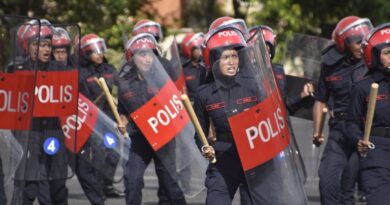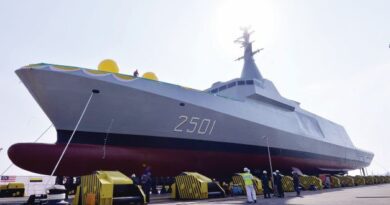Royal Malaysian Navy 15-5: Magnifying Mahan’s Seapower Calculus Or A Mere Myth
One analyst quipped the primary function of a Navy is to “Float, Move & Fight” in order to carry its raison d’etre in the words of Corbett to “secure the command of the sea”, while denying the adversaries command of the sea.
For a nation like us, with two theatres of operation divided by vast ocean between Peninsular and Sabah / Sarawak, it poses not only a unique challenge but a grave one to our Navy. Tentera Laut Diraja Malaysia as its widely known in Malay, once was the benchmark for the region without banking on any Western or Eastern Block support.
With acute strategic planning of Royal Malaysian Navy (RMN) Admirals of yesteryears, it was on path in becoming a reputable Green Water Navy by the late 70s up to early 90s. The advent of both Perdana and Handalan-class Fast Attack Craft (Missile) with its lethal MM-38 Exocet Surface to Surface Missile, tipped the naval balance in our favour for the better part of the 80s.

This was augmented by 6 x Jerung-class Fast Attack Craft (Guns) and supported by Mahameru-class (Mine Counter Measures) which further enhanced availability rate of surface combatants. In the 80s larger vessels such as Frigates and Corvettes were acquired in tandem with the enforcement of EEZ brought about by Flag Planting operations by our military at the fringes of our sovereign soil.
The induction of 2 x Kasturi-class, 4 x Laksamana-class and 2 x Lekiu-class continued to raise eyebrows among Navies of the regions. Finally, the 2 x Perdana-class submarines completed the 3-Dimensional warfare capabilities of our RMN in the realm of air, surface and sub-surface domains. Until the turn of the millennia, RMN was trailblazing ahead of the region in terms of both combat capabilities and combat aggregate power.
NGPV Debacle
However, the debacle Next Generation Patrol Vessel (NGPV) known as the Kedah-class, albeit originating from the proven and famed Meko 100 class started the rot in the long-cursed acquisition process for the beleaguered RMN. Under the pretext of localisation and transfer of technology what was supposed to be a planned procurement of 21 x NGPV was reduced to six owing to a combination of corruption, irregularities and downright treason by the local contractors.
Among the disappearing act in this man-made mishap was the promised Air-Defence Module, which remains forgotten albeit the adage ‘Fitted For But Not Equipped With”. The world-renowned spectacular blunder of the Second Generation Patrol Vessel (SGPV) also known as Littoral Combat Ship (LCS) or as the Maharaja Lela-class with fake cardboard mast, continuous to be a sad chapter for the otherwise a professional organisation like the RMN.
#15-5
To cater for the evolving dynamics of future warfare, the planners at RMN in 2015-16 came up with a transformational blueprint known as the Royal Malaysian Navy 15-5 Plan. It was envisaged that the current inventory of 15 classes of ships would be streamlined into only five class gradually. The underlying justification for this 15-5 is to reduce logistics footprints instead of having different types, origin and class of ships and also use up the funds from retired ship to procure more state-of-the-art vessels.
Thereby allowing the RMN with an Order of Battle (ORBAT) of flexible platforms / systems capable of addressing multitude threats, rather than an ideal platform / system for a specific threat scenario. In pursuance of this plan the FAC (M), FAC (G), Corvettes and Patrol Crafts will be retired to make way for only five class that will remain in their inventory. These are namely the Perdana-class Submarines, NGPV, LCS, LMS and MRSS. The Navy, known for its foresight, planned ahead until RMK 15 (2035-2040) with a force structure of 55 vessel with the following composition:-
- Next Generation Patrol Vessel (NGPV) : 18 units
- Littoral Mission Ship (LMS) : 18 units
- Littoral Combat Ship (LCS) : 12 units
- Multi Role Support Ship : 3 units
- Submarine : 4 units

Never Ending Saga of SGPV
How realistic is for the RMN to achieve this target remains arguable, owing to the continuous never ending saga of SGPV. The latest development seems to put the commissioning of the lead ship beyond 2026 (apart from cost overrun and reduced vessels) due to the delay in re-structuring, de-listing of Boustead Shipyard and incorporating it into a Ministry of Finance entity. With most of its Development Expenditure (DE) Fund stuck into the never-ending pit of LCS, RMN is faced with a double jeopardy.
Firstly, the delay in commissioning of these “Flagships” and compounded secondly with the rapidly ageing frontline vessels of RMN with the likes of Kasturi, Handalan and Perdana-class. The current average age of RMN ships are 30 years old with KD Sri Sabah (PC) being the oldest in inventory having been commissioned in 1963. RMN also earned the dubious distinction with the oldest vessel to participate in the prestigious RIMPAC Exercise with the US Navy last year.
Notwithstanding the professionalism, fighting spirit, espirit de corp, training, leadership and downright courage of our sailors and officers, modern naval warfare are measured in miliseconds and stand-off range to neutralise opposing forces, decisively. Current naval vessels especially surface combatants bristles with sophisticated sensors, weapons stations and protection suites to complete the Time Sensitive Targeting Loop of Find, Fix, Engage and Asses at a lightning speed. Thereby blurring the time and space between acquisition of target and its neutralisation at a dizzying realm unknown before.
A New Naval Arms Race?
Nation states in the periphery are gearing and beefing up their Navy, with Indonesia concluding 4 x FREMM Frigates plus 2 x Arrowhead 140 Frigates, Singapore with 4 x Type 218SG submarines and Philippines with Hyundai built Jose Rizal frigates. All these vessels featured low observability in terms of heat signature, acoustic and radar, while incorporating Artificial Intelligence and Augmented Reality Infused Bridge integrated to 3-dimensional warfare modules.
These neighbouring modern vessels will ply the waterways of Straits of Malacca and South China Sea in the coming decades. The big elephant in the room would be whether our Maharaja Lela-class LCS designed in 2011 is suitable to enter the electronically saturated sea waves in 2027 / 2028. Additionally, is the RMN 15-5 cognizant of the fact that certain class like the Minesweepers must remain in service to plug the gap of mission void. Finally and most important of all, whether the government of the day is expeditiously serious and has the political will in prioritising the Royal Malaysian Navy as the bulwark of our forward defence posture.
If not the RMN 15-5 will merely remain as a myth and the famed Seapower proponent Alfred Thayer Mahan would be rolling in his grave, due to the debacle brought about by a contractor to an otherwise formidable Navy.








